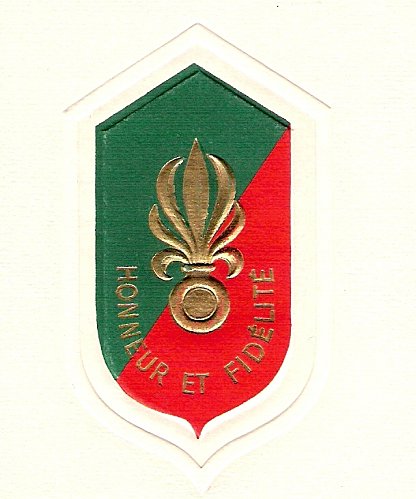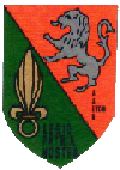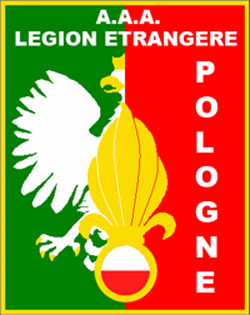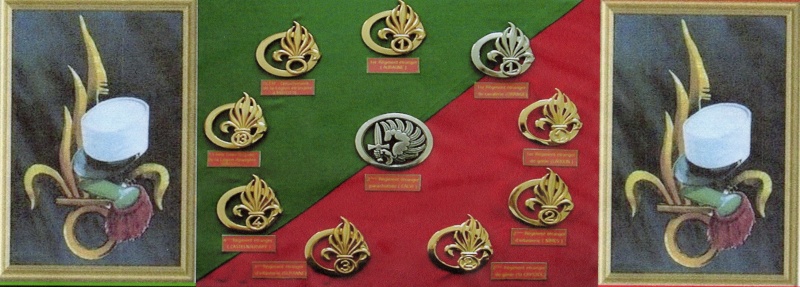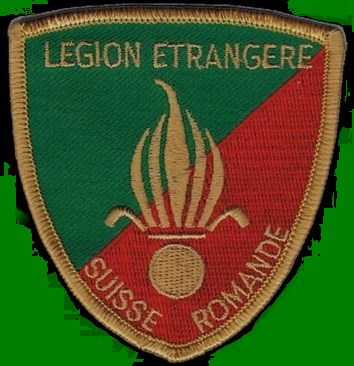
Eva du Monteil 2015/03/11

The Légion Etrangère has a history spanning over 150 years. Its troops include fierce soldiers from all over the world who share one thing in common – their desire to serve the Legion.
Here is how they respect and honor its impressive heritage.
‘Honeur et Fidélité’
While the motto of French Army units is ‘Honneur et Patrie’ (“honour and fatherland”), ‘Honor and Fidelity’ has been the motto of the French Légion since its beginnings. It signifies that loyalty goes well beyond one’s nationality, ethnicity or religion.
This motto was written on the banners of the units of Swiss mercenaries that fought for France during the Ancien Régime. It also became the motto of the Brigade from Southern Nice in 1985.
It is the first point of the Code of Honor, written in 1980 to serve as a set of rules that would guide the Legionnaire’s conduct.
The Grenade with 7 Flames
This insignia is a popular symbol used in the Legion, but it was originally only reserved for the elite units. In 1874, the Grenade was allowed throughout the Legion and is now featured on kepis and collars of the legionnaires since 1874. With time it modified and now represents 7 flames with two of them directed downwards, and the number of the regiment in the centre.
The French Foreign Legion Band
The reputation of the French Foreign Legion Band goes well beyond the frontiers of France.
Unlike other Military Bands, the pace of the Legion’s march is 88 steps per minute, equal to that of the former king’s soldiers and more solemn than other French military bands, whose pace is usually around 120 steps per minute.
The history of the orchestra in the Legion starts with the origins of the Legion itself, in 1831. At the time, the number of musicians in a military orchestra was restricted and consisted of a chief conductor, assistant conductor and 27 musicians.
By 1860, the musicians were already 40 and the number kept increasing. The Legion includes 60 accomplished musicians who tour the world 4 to 5 times a year today.
Le Boudin
Le Boudin, the Legion’s official march and a famous song in France. The lyrics were written in 1860 by Monsieur Wilhelm shortly before the Legion’s departure for Mexico and has evolved to address the Franco-Prussian War.
The song famously begin with: ‘Tiens, voilà du boudin, voilà du boudin, voilà du boudin’ and makes repeated allusions to the fact that Belgians were “lazy shirkers”.
At the time, the King of the Belgians wished to remain neutral in the Franco-German conflict and asked France not to commit the Belgian Legionnaires into the war.
It isn’t named after the traditional French blood sausage, but after the gear rolled up in a red blanket that used to top the backpacks of Legionnaires.
April 30: Camerone Day
The battle of Camerone is perhaps the most famous battle of the French Legion (See our previous article: Famous Battles of the French Foreign Legion)
Every year, Legionnaires gather to celebrate the exceptional courage and endurance in combat of their predecessors. Outnumbered, they relentlessly fought an entire Army in Mexico in 1863, earning the respect of their opponent when they ceased fire.
Today, the celebrations are held in Aubagne in the South of France, the main outpost of the Legion in France, and gather some 10,000 honored guests and Legionnaires. Aside from the celebrations, which include the reading of the Camerone Story and ceremonial drills, the event takes the form of an ‘Open House Day’ and allows locals to know more about the Legion.
Le Képi Blanc or White Kepi
A powerful symbol of the Legion, the White Kepi, only became part of the uniform over a century after the Legion’s creation, on July 19, 1939. Today, it is the most perfect embodiment of the Legion, so much so that ‘un képi blanc’ actually means ‘a Legionnaire’ in French.
Its official origins come from the Legion’s legendary involvement in the Second World War, and stem from practicality: it was an additional neck-protection against the hot African sun. Still, it was already in use in 1907 in the units who fought in Morocco with a khaki cover as a protection. However, the color would fade with the sun and washing.
This changed with the 1939 14th of July parade, when Legionnaires wore white kepis, and successive regiments began to wear the white kepis from then on. It is also the name of the Legion’s magazine.
Le Bérét Vert or Green Beret
Legionnaires are known and expected to pay special care to their outfit.
Since 1957, the green beret has become the official hat worn by Legionnaires off combat. Worn during exercise and off duty, it includes the Grenade with 7 flames and its colors vary according to the unit to which one belongs.
By contrast, French paratroopers wear a red beret and Air Army soldiers, a blue beret.
Christmas
Christmas is no Christian celebration in the Legion: it is a time to gather and honor the ‘Legion family’.
More than any other units in the French Army, Christmas is the occasion to celebrate Legion values of camaraderie, unity and solidarity within a Regiment. Given the fact that Legionnaires often come from different religious and ethnic backgrounds, Christmas doesn’t take a religious form in the Legion. Although presents are exchanged and a meal is shared, the goal was to bring people together regardless of their rank, enable them to honor the past and make wishes for the future together.
Christmas celebrations started after the Franco-Prussian War in 1870. Back then, Legionnaires only received a quarter of hot wine, but over time festivities really started taking place. From living crèche to shows featuring dances, firemen and ventriloquists, Legionnaires passed on the traditions even on combat scenes.









































